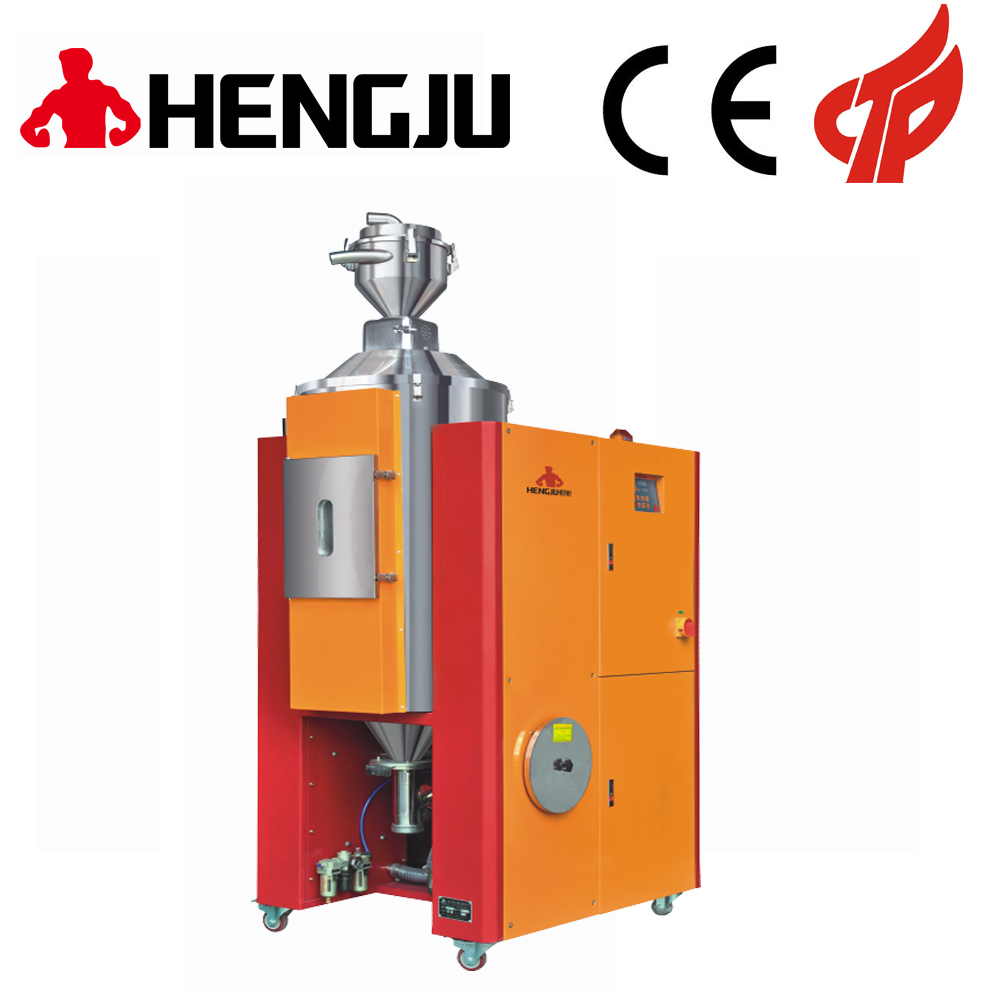Although the drying of plastic particles is a relatively simple process, in some cases, the particles cannot be completely dried.
The factors that affect the drying effect are:
1). Drying temperature:
Heat is the key to unlock the force between the water molecules and the hygroscopic polymer. When the temperature is higher than a certain temperature, the attractive force between the water molecules and the polymer chains will be greatly reduced, and the water vapor will be taken away by the dry air.
2), dew point:
In the dryer, the humid air is first removed to make it contain very low residual moisture (dew point). Then, heat the air to reduce its relative humidity. At this time, the vapor pressure of dry air is lower. By heating, the water molecules inside the particles get rid of the bondage of the bonding force and diffuse to the air around the particles.
3). Time:
In the air around the particles, it takes a certain time for the absorption of heat and the diffusion of water molecules to the surface of the particles. Therefore, the resin supplier should specify the time it takes for a material to be effectively dried at the appropriate temperature and dew point.
4). Airflow:
The dry hot air transfers heat to the particles in the drying silo, removes moisture on the surface of the particles, and then sends the moisture back to the dryer. Therefore, there must be enough airflow to heat the resin to the drying temperature and maintain this temperature for a certain period of time.
2 When there is a problem of poor drying, the problem should be found from the following three aspects:
1), the condition of the dryer
When inspecting the dryer, pay special attention to the air filter and hose. A clogged filter or a squashed hose will reduce airflow, thereby affecting the operation of the dryer;
A damaged filter will contaminate the desiccant and inhibit its ability to absorb moisture; a broken hose may introduce moist ambient air into the dry airflow, causing the desiccant to prematurely absorb moisture and high dew point; hoses and desiccants with poor insulation measures The bin also affects the drying temperature.
2), dry air circuit
In the drying air circuit, the drying temperature should be detected at the entrance of the silo to compensate for the heat loss of the dryer in the hose. The low air temperature at the inlet of the silo may be due to improper adjustment of the controller and lack of insulation, or malfunction of the heater element, heater contactor, thermocouple or controller. In addition, it is also important to monitor the drying temperature throughout the drying process and observe temperature fluctuations when the desiccant is replaced.
If the material is not properly dried after coming out of the dryer, check whether the drying silo has enough space to provide sufficient and effective drying time. The effective drying time refers to the time the particles are actually exposed to the appropriate drying temperature and dew point. If the particles stay in the silo for insufficient time, they will not get proper drying. Therefore, attention should be paid to the size and shape of the granular material or crushed material, which will affect the bulk density and residence time of the dried material.
A kinked hose or a clogged filter can restrict airflow and affect the performance of the dryer. Therefore, if you check the dryer and find no such problems, you cannot judge whether the airflow is sufficient. Here, there is a quick, simple and accurate method to detect whether the airflow of the dryer is sufficient, that is, to measure the vertical temperature curve of the material in the drying silo.
It is assumed that the drying time recommended by the material supplier is 4h, and the processing capacity is 100lb/h (1lb=0.4536Kg). To determine whether the airflow of the dryer is sufficient, you can measure the temperature curve in the drying silo. Here, pay special attention to the temperature at 4h (400lb). If the temperature at the 400lb material level in the dry silo reaches the set value, then the air flow can be considered sufficient.
If only the material at 1h, 2h or 3h in the drying silo is fully heated, it means that the air flow cannot complete the heating and drying of the material at the predetermined yield. Insufficient heating may indicate that the drying silo is too small for this rate of production, or the airflow is restricted due to clogged filters or damaged hoses. Excessive air volume can cause problems, which not only wastes energy, but also causes high return air temperature and destroys the performance of the desiccant.
The return air filter can prevent the filamentous material from polluting the desiccant and affect its moisture absorption performance. These filters must be kept clean to ensure adequate airflow.
When the dry air comes out of the top of the dryer, most of the heat has been released. When the desiccant temperature is in the range of 120oF to 150oF, most dryers can work efficiently. If the return air overheats the desiccant, it will reduce its ability to absorb moisture in the dry air.

Always check the return air temperature of the dryer. When the return air temperature is high, it may indicate that the size of the dryer is too large for the productivity, or the temperature of the material entering the drying silo is high, for example, PET has crystallized before drying, or only some materials (such as PET ) The drying temperature is higher than the normal temperature range. In order to prevent the return air temperature from becoming high, as long as a heat exchanger is installed in the return air path, the desiccant can effectively remove the moisture in the dry air.
3) Regeneration and cooling of desiccant
The moisture absorption capacity of the desiccant is limited, so the moisture absorbed by it must be removed by regeneration. The process is: when the ambient air is sucked in, it enters the blower through a filter, and then is sent to a set of heaters. The heated air passes through the desiccant bed. When the temperature of the desiccant rises, the adsorbed moisture is released. When the hot air is saturated with water vapor, it is discharged into the atmosphere. The high-temperature regenerated desiccant must be cooled before returning to the drying loop to restore the moisture absorption function of the desiccant.
Dew point readings can help find some problems, so the dew point of dry air should be monitored throughout the drying process. The dew point reading during normal operation of the dryer should be a straight line in the range of 20oF to 50oF. Of course, small fluctuations caused by replacing the desiccant are normal. If the dryer is operating normally, the dew point at the dry air inlet should be at least 30oF lower than the dew point at the return air outlet.
On the other hand, after the desiccant is replaced, the dew point immediately peaks, indicating that the desiccant is not sufficiently cooled before being put in, so that it cannot absorb moisture well. After cooling, the dew point of the desiccant will drop to the normal standard. If the desiccant is not properly cooled, it will cause a temperature peak, and a sudden temperature change will reduce the desiccant's ability to dry heat-sensitive materials such as ionomers, amorphous polyester and certain nylon grades.
If the dew point reading is normal after the desiccant bed is replaced, but the dew point rises rapidly before the end of the drying cycle of the desiccant, it means that the ambient air may have entered the closed air circuit, causing the desiccant to absorb moisture prematurely. Another possibility is that the desiccant regeneration is incomplete or contaminated. If the dew point reading is close to the return air dew point reading, it indicates that the regeneration air circuit is completely ineffective or the desiccant is seriously polluted.
|
 +8613669807274
+8613669807274
 +8613669807274
+8613669807274 wto-btb@wto-btb.com
wto-btb@wto-btb.com Tel: +8613669807274
Tel: +8613669807274 SMS: +8613669807274
SMS: +8613669807274